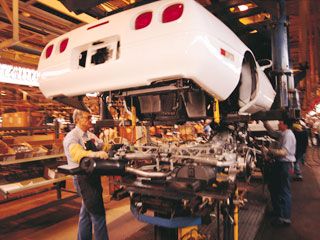The automobile industry is, after all, a business – at least in theory – so, it should come as no surprise that stock market analysts and financial “experts” have things to say about it. But, sometimes you wonder about these people.
Once such occasion has been served up by Fortune magazine’s senior editor, Alex Taylor III, who writes about the industry’s 2007 and his expectations for its 2008.
He starts off by saying that Cerberus is “turning upside down,” but that new boss Bob Nardelli’s “got a lot of work to do. Chrysler is expected to lose more than $1 billion in 2007.”
Where has Mr. Taylor been? Chrysler’s already withdrawn that estimate and substituted a different one: $1.6 billion – 60% larger than its original forecast. Mr. Taylor seems to have missed that item, and perhaps have missed the simultaneous abandonment by Chrysler of its claim that it would break even in 2008.
Taylor says “Chrysler is talking to China’s Chery about building small cars.” Wrong, again. Chrysler cut a deal with Chery for one small car while Daimler still owned the company. Since then, it has specifically stated that it is NOT contemplating further deals with Chery.
Then he says that “speculation is building about Cerberus’ exit strategy from Chrysler, as well as its timing. Will it try to merge Chrysler with Ford, or sell it to another automaker, or go to the public with an IPO ? If Chrysler continues to pile up losses, investors may get anxious and Cerberus will have to bail out sooner than it wants to. In an industry used to working in four-year product cycles, fast private-equity money will likely speed things up.”
This statement is just plain baffling.
In a sense, it’s a retread. Rumors abounded that GM was interested in buying Chrysler when it was for sale by Daimler, but those rumors turned out to be fantasy. The notion that Ford or GM would now be interested in Chrysler, in a down car market when both companies are still trying to eliminate both capacity and workers, is beyond comprehension.
More to the point, what possible benefit could accrue to either Ford or GM from acquiring Chrysler? Though Mr. Taylor seems to have missed it, Nardelli just called Chrysler “operationally bankrupt.” Anyone buying Chrysler inherits all of its union contracts, its various accrued liabilities, and its obligations to dealers. The only thing Chrysler’s got that’s worth anything is Jeep, and it’s not worth taking over the whole company.
Mentioning Ford as a possible suitor is particularly bizarre: Ford’s financial lifeline is somewhat better than that of Chrysler, but not much. Moreover, Ford is in desperate trouble, with sales plummeting. Ford is holding on for dear life, hoping that it can get new models to market in time and that they all click.
But it is the remark that “investors may get anxious and Cerberus will have to bail out sooner than it wants to” that is most weird.
To whom is Taylor referring? Surely not investors in Chrysler. There are only two: Cerberus, with 80% of the company, and Daimler with 20%. There are no other stockholders. It’s a private company now. Or is he referring to the bondholders, the people holding the debt instruments that Chrysler issued to finance the buy-out? Chrysler doesn’t have much need to respond to them, either, at least as long as it’s making the payments. They already coughed up the money.
Or is it the investors in Cerberus that he’s talking about? Cerberus didn’t buy Chrysler with its investor’s money. It bought it with borrowed money. Sure, if Chrysler tanks, then the stock is worthless and the value of Cerberus’ holdings zeros. But it wasn’t their money in the first place. So, they don’t lose. The bondholders lose.
Taylor also seems to think that “fast private equity money” will speed up product development at Chrysler.
That remark is truly entertaining. Apparently, the theory is that Mr. Nardelli, in the process of turning Chrysler “upside down” will invent a previously unknown way to bring new products to market more quickly. That is, someone who has absolutely no experience in the automobile industry will rapidly discover a way to develop new products at half the price and in half the time as the rest of the industry.
History doesn’t offer much support for the notion that product development timetables can be shortened in the auto industy. Bob Lutz still holds the record: three years to develop the first Viper. But that was a very basic car, using an engine off the parts department shelf and an out-sourced transmission. If anything, the product development lead time is likely to grow because meeting the new federal fuel efficiency standards will require more engineering work, particularly on weight saving, than in the past. Chrysler appears to be further behind than any other automaker in developing systems, such as hybrid powertrains, that may be needed for products hitting the market in the future.
Of course, Mr. Taylor is a senior editor of Fortune, so it follows that he is a man of wisdom, insight and financial acumen. So, he must know what he’s talking about.
But, then John Snow is a former Treasury secretary, another man of financial acumen and insight.
He’s the head of Cerberus.
And he bought GMAC, just before the mortgage crisis hit.
And he bought Chrysler, just before the mortgage crisis triggered the credit crunch and the housing slump.
But, then, perhaps that was all part of the plan.

